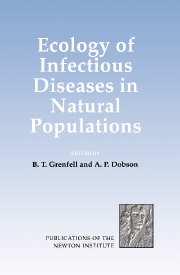Book contents
- Frontmatter
- Contents
- List of Participants
- Introduction
- BROAD PATTERNS AND PROCESSES
- Impact of Infectious Diseases on Wild Animal Populations: a Review
- Microparasites: Observed Patterns
- Mathematical Models for Microparasites of Wildlife
- Microparasite Group Report
- Macroparasites: Observed Patterns
- Mathematical Models for Macroparasites of Wildlife
- Macroparasite Group Report
- Critical Evaluation of Wildlife Disease Models
- PATHOGENS, INSECTS AND PLANTS
- IMPACT OF ECOLOGICAL AND GENETIC HETEROGENEITY
- Glossary
Impact of Infectious Diseases on Wild Animal Populations: a Review
Published online by Cambridge University Press: 22 January 2010
- Frontmatter
- Contents
- List of Participants
- Introduction
- BROAD PATTERNS AND PROCESSES
- Impact of Infectious Diseases on Wild Animal Populations: a Review
- Microparasites: Observed Patterns
- Mathematical Models for Microparasites of Wildlife
- Microparasite Group Report
- Macroparasites: Observed Patterns
- Mathematical Models for Macroparasites of Wildlife
- Macroparasite Group Report
- Critical Evaluation of Wildlife Disease Models
- PATHOGENS, INSECTS AND PLANTS
- IMPACT OF ECOLOGICAL AND GENETIC HETEROGENEITY
- Glossary
Summary
Introduction
It is well accepted that infectious diseases have been among the dominant selective forces influencing human populations over the past 10,000 years (Haldane 1949, McNeill 1976). However, despite theoretical studies suggesting parasites may be involved both in the regulation of host abundance and the maintenance of host genetic diversity (Anderson and May 1978, May and Anderson 1978, Anderson 1979 and 1981, Hamilton 1982, O'Brien and Evermann 1988) our understanding of the impact of infectious diseases on wild animal populations remains poor. Although parasitism, by definition, is associated with morbidity and mortality of the host (Anderson and May 1978, Price 1980), the traditional belief has been that ‘well-adapted’ parasites do little harm to their hosts, so as to prevent their own eradication (Grundman et al. 1976, Price 1980). This view is now questioned, as theoretical studies indicate that many co-evolutionary pathways may be followed, depending upon the relationships between parasite pathogenicity and transmission efficiency (Anderson and May 1982, May and Anderson 1990, Dobson and Merenlender 1991, Toft and Aeschlimann 1991). Thus, although the literature abounds with reports of infectious disease agents causing mortality in individual wild animals, these cases have been interpreted as resulting from an ‘imbalance’ in the natural host-parasite interaction. Such ‘imbalances’ may result from the introduction of an infectious agent into a naive wildlife population by man, classically exemplified by avian malaria in Hawaii and rinderpest in Africa (Warner 1968, Van Riper et al. 1986, Plowright 1982), or by an alteration of the host's resistance to infection.
- Type
- Chapter
- Information
- Ecology of Infectious Diseases in Natural Populations , pp. 20 - 51Publisher: Cambridge University PressPrint publication year: 1995
- 93
- Cited by



